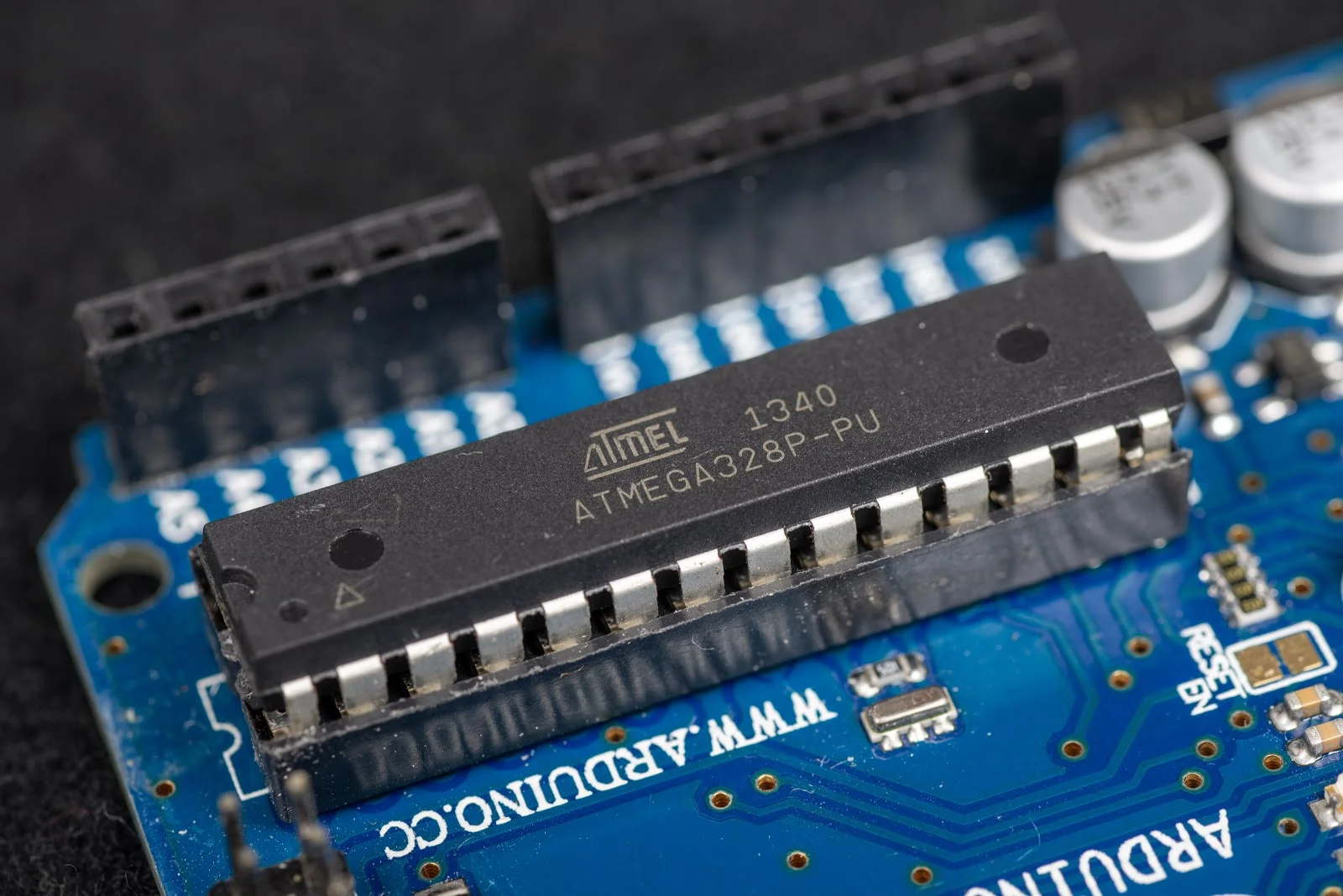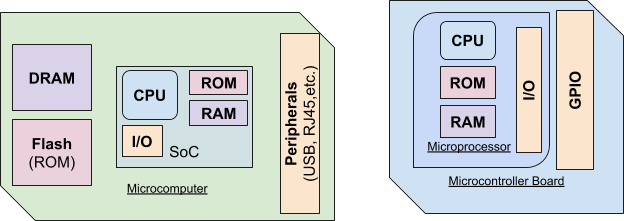Microprocessors and Microcomputers Hardware and Software 6th Edition Reddit
Microprocessor vs Microcontroller vs Microcomputer

With the 50th ceremony of Apollo eleven's moon landing just recently, permit'due south have a moment to reminisce how flesh first took a foothold on the moon on lath a spaceship with less computational power than your smartwatch. You heard right, one-half a century agone the Eagle Lander and Saturn 5 relied on a module called the Apollo Guidance Computer. Weighing in at 70 lbs, it had two Kbits of memory and ran at roughly 2MHz (roughly 1/8th of an Arduino at a fraction of the size and weight). And forget annihilation y'all idea you lot knew about electronics, this module did not rely on transistors, it relied on what was called Rope Cadre Retention which was essentially wires weaved in specific patterns. V decades subsequently, nosotros find ourselves with the entirety of NASA'due south Lunar programme processing ability in our pockets cheers to the invention of microscopic switches known equally transistors. These are in fact so tiny that y'all can fit several millions of them on a tiny chip, hence the nativity of the word: microsystem electronics.
Did y'all know? The micro symbol μ, Mu, is the 12th letter of the Greek alphabet and was derived from ancient Egyptian hieroglyphs meaning "h2o". In Greek numerals it has a value of 40, however, today it is a unit prefix in the metric arrangement defining one-millionth (ten−6). Its name comes from the Greek word μικρός (pronounced "mikros") significant "modest".
Microsystem electronics - as the proper noun implies - deals with all things electronic and all things micro - such equally a microprocessor. You may have heard other such words, like microcontroller, or microcomputer. But what is the difference between a microprocessor and a microcontroller and a microcomputer? Let'south briefly dig into what these are and what they mean.
Microprocessor
Likewise known as CPU (Cadre or Key Processing Unit)

Most every single modern slice of engineering science today has a microprocessor, also known equally a CPU, or Central Processing Unit of measurement. Without a microprocessor, your computer would just exist a box filled with cables and miscellaneous hardware; the CPU is the middleman to all the other internals. If information technology doesn't have a processor, so it is role of 1 since these lay the barebone structure of any circuit logic with the help of transistors. If y'all've ever seen the raw guts of a reckoner, it's commonly the most prominent part: a small shiny slice of aluminum in the middle of the motherboard. Information technology is oftentimes hidden behind a heatsink and fan to protect its frail structure of minuscule components from overheating. The quality of a CPU is most-frequently divers by the number of Cores it has (unmarried, dual, quad, etc.) and the frequency at which it runs (in Hz). The faster it works, the more power it consumes, which is why most CPUs tin be "overclocked" to run faster if higher voltage tin can be supported and if the excess heat can be dissipated fairly (sometimes besides referred to as "overvolting").
Microcontroller
Also known every bit MCU (Micro-Controller Unit)

Much like a microprocessor, a microcontroller is the nervous organization of a body. Whilst the onetime "processes" data, the latter "controls" data and peripherals. Recollect of it as both sides of the brain: one is the thinking side, whereas the other one is the motor skills and expressive side. On its own, a microprocessor won't exercise much; It's like a brain without a trunk. Slap on a nervous system (busses), some limbs (IO) and a beating heart (crystal clock) and yous've got yourself a microcontroller. The most common example of these is an Arduino Uno; however, this is a user/beginner-friendly breakout. The actual microcontroller is the chip yous see on the Uno which comes in a variety of footprints. It contains the bare minimum to run simple logical operations: a microprocessor (CPU), retention (RAM), storage (ROM), IO, busses, power management and others depending on the variant.

The Arduino Uno sports an ATmega328P microcontroller which has a single-cadre AVR CPU that can run at speeds of up to 20 MHz. The Arduino clocks it down to 16 MHz to continue it cool and steady.
Microcomputer
Too known every bit the Computer, just… Tiny.

The new RPi-4B sports a broadcom BCM2837B0 SoC, which has an integrated quad-core ARM Cortex-A53 CPU running at a swift i.4 GHz.
Equally we've seen previously, a microcontroller contains a microprocessor. In the same way: a microcomputer contains a microprocessor as well. Some microcomputers may too contain born microcontrollers (such as the Raspberry Pi). Microcomputers are merely similar regular computers, except they pack everything in the smallest footprint possible - oftentimes with the use of a SoC (System on a Chip) - which is the big sister to the weaker microcontroller. Microcomputers are generally meant to run a full-fledged Operating System (Os), then they will oft rely on external RAM and ROM, and employ mutual peripherals such as USB or RJ45 (Ethernet).
Decision
Microprocessors are a key element to whatever electronic component. You lot volition discover them in any organisation that requires logic, no affair how small or unproblematic. Any arrangement of transistors and logic gates are what form a microprocessor. The latter is also present in both Microcontrollers and Microcomputers; both of which are essentially the same but built for unlike purposes: the microcontroller does basic logic and requires little time and components to do and so, whilst the microcomputer does heavier computation and requires a longer time and more power to practise so.

CPUs are part of Chips such as SoCs and MCUs, which in turn are part of a lath such every bit a Microcomputer (RPi) or a Microcontroller Lath (Arduino).
Despite non relying on any of these mod technologies, and using equipment with a billionth of the processing power of what today's computers are capable of, the brave makers and engineers of the globe have however managed to send people into space and on the moon. This goes to show that - even with half a century of a technological gap - great things aren't achieved by how expensive or powerful your equipment is: they're made with your conclusion and the ability of your mind. And so grab some cheap components and go turn yesterday's fantasies into tomorrow's reality!
0 Response to "Microprocessors and Microcomputers Hardware and Software 6th Edition Reddit"
Post a Comment